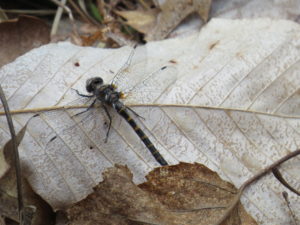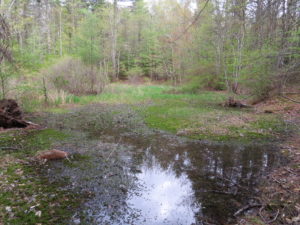(by Pam Hunt)
The Ringed Boghaunter is the only dragonfly on NH’s threatened and endangered species list. This insect has a restricted range in the Northeast: from western and southern Maine to eastern Connecticut, with historic records in NY and NJ. Here in the Granite State it’s only been found in the southeast (Strafford to Amherst). During the NH Dragonfly Survey (NHDS) from 2007-2011, volunteers almost doubled the number of known sites for the species, and a handful of additional places have been found since, prompting the boghaunter to be reclassified from endangered to threatened in 2017.

It’s now been ten years since the NHDS ended, and in that time a handful more boghaunter sites were discovered, bringing the total at the start of 2021 to 20. Many of the older sites, however, haven’t been visited since 2010, and this paucity of recent data led me to implement a new round of surveys. The call went out to volunteers, and as luck would have it, two landowners known to support Ringed Boghaunters independently asked about resurveying their sites. Thus the hunt was on.
Boghaunter habitat is – as the name implies – boggy, and all occupied wetlands have a significant component of sphagnum moss. Beyond that they show a lot of variation, including cedar swamps, blueberry swamps, and more traditional floating mats. Most are also relatively small (often less than an acre), which means the landscape is covered with potential habitat – even if most of it seems unoccupied. In 2021 we decided to focus most of our efforts at known sites, largely so we could update the database, and will shift gears toward more exploratory surveys in subsequent years.

Because this species has a very early flight season for a NH dragonfly (most records are between May 1-20), there was little time to waste, and some of us got out looking in the last week of April so we’d be sure we caught their emergence. The first sighting of the year was of four individuals at a large wetland complex in Fremont, and this got all the volunteers eagerly searching their assigned areas. Despite this flurry of activity (and good weather), the next sighting was a full week later – and at the same site in Fremont. The exciting news was that our team of five ended up seeing 15+ individuals along 1.5 miles of railroad grade, clearly indicating that this was a significant population. Over the next week, boghaunters were confirmed at an additional five sites, while surveys at another six continued to come up empty. Most recently relative to press time, one was finally found at a site in Strafford on May 24 – on the last of four trips there. Overall, of 13 sites visited at least once in May, we found our target at seven, and surveys at a handful of potential sites all came up empty. It’s certainly possible that boghaunters still occur at the sites where we missed them, as the Strafford story above makes abundantly clear: you can search and search, and almost give up, only to find one when you thought you were done.
What might cause boghaunters to disappear from a site? Some threats are natural, such as flooding by beavers or a wetland filling as a result of succession. Others are tied to people, including changes to water chemistry due to run-off or altered hydrology resulting from construction. Even things like climate change likely have an impact through the timing, frequency, and intensity of precipitation. Knowing which threats are most important to NH’s boghaunters requires us to have better data on where they are and where they clearly have disappeared. Thus, as the 2021 season winds to a close, we’re already considering our options for 2022. Certainly we’ll revisit sites where boghaunters were missed in 2021, but we also want to branch out and explore a lot more potential sites. The success rate may be low in the latter situation, but it’s the only way to get a better handle on the state’s population.
